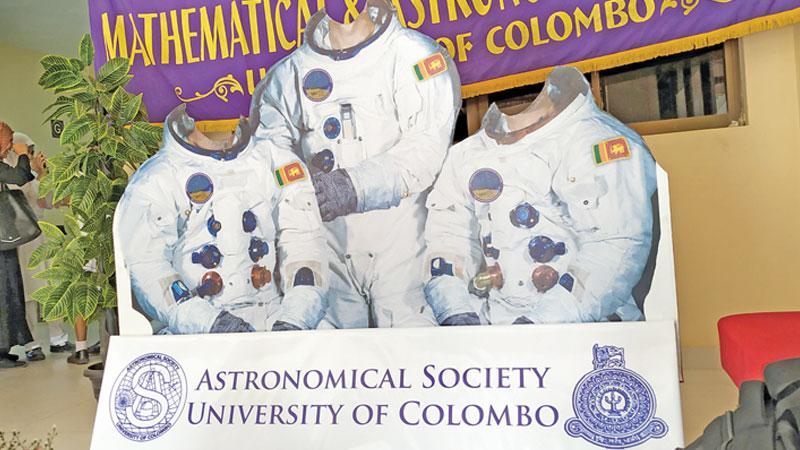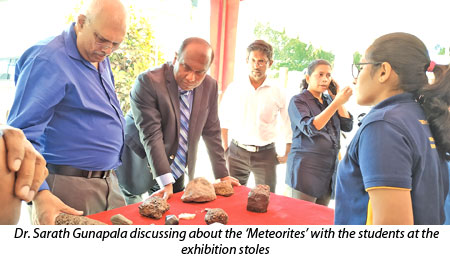
Exploring the outer space has always been more of a tenacious work and it takes much of innovatory guts to come up with quests to skim through the cosmos. Even though we come across only a handful of inventions and experiments in line with Earth Science, every passing moment, the astronomers are constantly making newer attempts to traverse the universe. So in the immediate future, we’re going to witness how Mars, whose movements keep on influencing us all the time, is reached by the astronauts from NASA. The future is going to bring a lot of Space Science experiments into reality. So we need to stay tuned for the most exciting ones.
 Dr. Sarath Gunapala, physicist, senior research scientist and group supervisor at NASA’s Jet Propulsion Laboratory, spoke to the Sunday Observer on some of the imminent technology advancements of NASA at a Space Exhibition held at the University of Colombo.
Dr. Sarath Gunapala, physicist, senior research scientist and group supervisor at NASA’s Jet Propulsion Laboratory, spoke to the Sunday Observer on some of the imminent technology advancements of NASA at a Space Exhibition held at the University of Colombo.
Dr. Gunapala specified several key advancements that are to be launched in the coming years. Mars 2020 is a mission by NASA’s Mars Exploration Program. It is a rover like ‘Curiosity’ launched in 2011. “It is the same rover, the same architecture” said Dr. Gunapala. “This rover will be launched in 2020 with the aim of collecting samples of Mars. The ‘Europa Clipper’, is another interplanetary mission that will be launched in 2023. NASA has just started working on this mission and are hoping to find liquid water and other objects necessary for life, in the ‘Galilean moon’ Europa.
In addition, people are building huge telescopes (GMTs). The Space Telescopes (JWSTs) are important to find life. Through the Space Telescopes, the astronomers will be able to see the blue planets hovering around the medium size stars like our Sun.
 “When we search for blue planets, we are looking for ‘medium size’ stars, because, the giant-size stars burn very quickly. They are not steady for billions of years. However, the smaller stars are stable, and can exist for hundred billion years. But, they are not suitable for life since they cannot give enough heat to keep water in ‘liquid’ form. So, the medium ones like ours (Earth), are stable for 10 billion years, and have enough time to form life. If there are planets like Earth, going round the right distance, not too hot, not too cold, it can keep H2O in liquid form. We call it ‘blue’ because of water” Dr. Gunapala explained.
“When we search for blue planets, we are looking for ‘medium size’ stars, because, the giant-size stars burn very quickly. They are not steady for billions of years. However, the smaller stars are stable, and can exist for hundred billion years. But, they are not suitable for life since they cannot give enough heat to keep water in ‘liquid’ form. So, the medium ones like ours (Earth), are stable for 10 billion years, and have enough time to form life. If there are planets like Earth, going round the right distance, not too hot, not too cold, it can keep H2O in liquid form. We call it ‘blue’ because of water” Dr. Gunapala explained.
These telescopes possess the techniques to generate good images as Space Telescopes. Pertaining to the advancements on telescopes detecting signatures of life elsewhere, Dr. Gunapala noted a telescope namely, ‘WFIRST’, 2.2 or 2.4 mirror telescope that will be coming out, hopefully in 2024. WFIRST will be unique since it is supposed to have the option or the ability of blocking the light from the sun in the middle, by giving people the room to see the planets around the other stars. This telescope is also capable of sending the light going through the atmosphere of a planet via a spectrometer and finding out whether they have favourable gases and vapour. This is in aid of the explorations of water-based planets.
Apart from that, he mentioned about a joint mission where they are talking with the Indian Space Agent to Venus. ‘However, in Venus, there won’t be life since its inside temperature is Celsius 650’. Obviously, there are no intelligent lives or trees on these planets. NASA strives to continue their missions in search of favourable conditions for ‘Primodial Soup’ (a solution rich in organic compounds in the primitive oceans of the earth, from which life is thought to have originated) and to search for any traces of life on Mars when it had running water.
When asked about NASA’s experiments Dr Gunapala explained as follows.
We know that NASA engages in a lot of Earth Science. There are numerous satellites to find out the Earth’s weather conditions, the celerityof ocean water, agriculture, space weather and a lot more. There are satellites that are set even to find out which radiation burst is coming from the sun that has the potential to do a major damage to electronics and equipment. If we are to be a bit aware of the universe, or about the sun, it always has these bursts, which are called ‘Coronal ejections’. These ejections go to different directions from the sun. What is important to find out is, whether there is a coronal ejection exactly towards Earth. If such an ejection occurs, it may be too disastrous. In 1859, a coronal ejection occurred and it was named, ‘Carrington Event’ which is the most powerful storm on record. When the ‘Carrington Event’ (a powerful geomagnetic solar storm) occurred, the ‘aurora borealis’ was visible from the Equator. (a natural electrical phenomenon, the appearance of reddish or greenish lights in the sky, especially near the northern or southern magnetic pole. This effect is caused by the interaction of charged particles from the sun with atoms in the upper atmosphere). If such coronal ejections occur now, the damage that our electronics, satellites and telecommunication systems would have to undergo is beyond imagination. In today’s world, we can’t imagine life without power, telecommunication, electronics and transportation.
NASA has three types of missions; flagship mission, new frontiers mission and discovery mission. InSight Lander to Mars is a discovery mission. It is a big leap in probing the interior of Mars. InSight is a satellite built by Lockheed Martin which has three main instruments; seismometer, thermometer and RISE. The seismometer is to measure the Marsquakes, the thermometer is set to sense the underground heat and RISE (The Rotation and Interior Structure Experiment), will provide information on the Martian core including its shape and weight. NASA has also set a satellite called ‘SOHO’ to acquire knowledge of the coronal ejections coming towards Earth.
According to Dr. Gunapala, we are incapable of doing anything to avoid a coronal ejection, but we can try to minimize the damage by taking certain steps like turning off the satellites. In the attempt to find out traces of life on Mars, then and now, NASA’s aim is to discover if Mars supports some kind of ‘Microbial life’ at this point.
